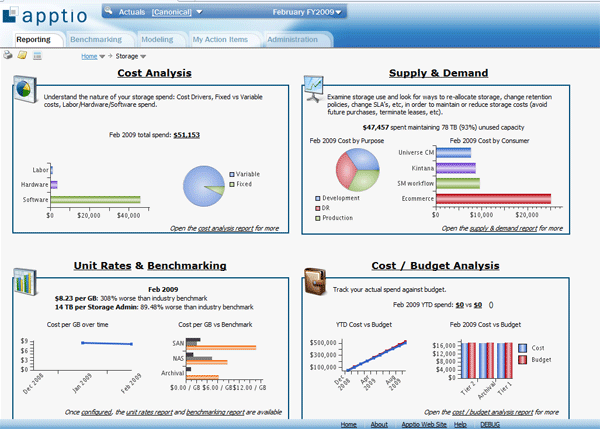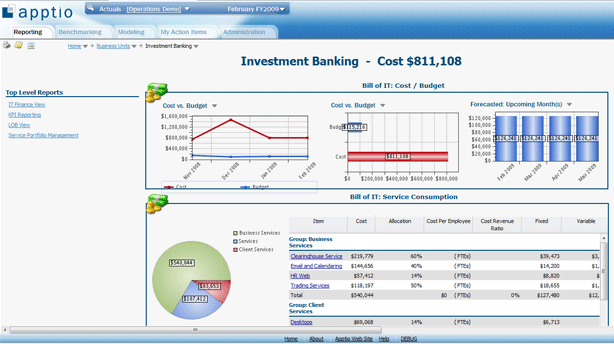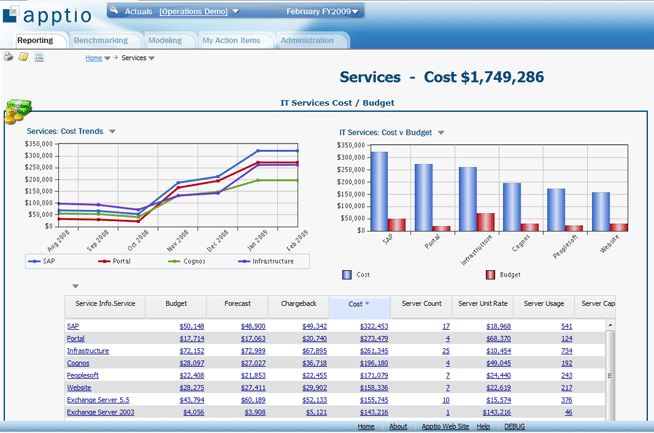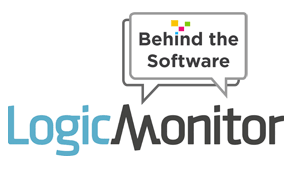IT Infrastructure Monitoring
Run IT Like a Business With Apptio TBM

Apptio’s Technology Business Management solution represents a fresh take on managing the cost, quality, and value of IT services. Apptio Director of Product Marketing John Novak joined us to speak about the IT challenges facing businesses today, and how Apptio TBM is innovating to create solutions.
To learn more about Apptio, visit their website. For more information on specific IT management software solutions visit our Top 10 IT Infrastructure Monitoring report and our collection of IT infrastructure monitoring blog posts.
How was Apptio founded, and what was the inspiration behind its founding?
Our founder and CEO, Sunny Gupta, is a 20+ year software veteran. He’s worked for a number of different companies and he’s a consummate entrepreneur, consistently looking for problems customers are trying to solve. In his prior experience, Sunny had the opportunity to engage a number of IT executives, CIOs, and heads of shared services, and ask them, “What are some of the challenges you’re trying to solve in the organization today that there are no answers for?” That started a great conversation with different customers in all types of verticals around this challenge of trying to run IT like a business. What they were telling us is, “We have all this data, from which we can tell a lot about our infrastructure or our other pieces of IT, but we can’t get a holistic view of where we’re going from a business perspective.”
Everyone from global financial services companies to manufacturers and consumer package goods companies were trying to make daily decisions around IT, but lacked a system in which to manage their IT business and make decisions. So that was the challenge we heard, and that’s really how Apptio TBM was born—out of dedication to solving that challenge for our customers.
How do you go about helping businesses overcome those challenges?
What we’ve done here at Apptio is we’ve pioneered a new category called Technology Business Management, and our Technology Business Management solution suite enables IT leaders to manage the cost, quality, and value of their IT services.
What that means in plain English is we provide a set of five applications that are run as a Software-as-a-Service solution that enable businesses to cost their IT services, to communicate the value of IT to business in what we call a Bill of IT, to strategically align and plan budget to forecast their business, and to do benchmarking so they can understand their cost structure and how they compare to industry peers, as well as how they compare to the delivery IT services or say Amazon or Azure, or other cloud service providers.
So really it’s enabling, through these five applications offered as a Software-as-a-Service, the ability for customers to manage their business and process of IT.
How do you make sure Apptio TBM stands out from all the industry noise?
First and foremost, what we do is very unique. We are essentially building a new category. So the fact that it’s a new category and that it’s something new that truly goes to the heart of what customers are trying to address, which is solving this challenge of—how does IT become even more of a business enabler? How does IT help the business grow and innovate? That’s a key factor.
CIO’s, the heads of shared services, and the CFO’s of IT have all been looking for an answer, and today they’re doing a lot of this in spreadsheets, which don’t give them the real-time analytics they need to make these decisions. There’s no operationalization of how IT goes about doing these things. It’s time-intensive and not very accurate. So this new category is going to the heart of what they’re trying to address, and it’s done in a very unique way.
How do you see the IT industry evolving?
IT is going through a radical change today due to a number of factors. One is that you have very disruptive technology that’s emerged over the last few years—things like virtualization, public and private cloud, new and innovative forms of outsourcing, and the emergence of other third parties. So not only has the technology changed, but it has allowed the business model of IT to evolve and change.
On top of that, in the new economic reality that we’re in, you’ve got the business now asking IT to come to the table and provide the same types of metrics, and contribute to decision-making processes by answering the same types of questions that all the other heads of the business are asked to answer. So with this increased need for transparency from the business perspective there’s a new bar for IT as well. So you have disruptive technologies that are changing the economics of IT, and you’ve got the business wanting increasing transparency, and that is all adding up to be a new model for IT. What we hear from our customers is that IT is really looking at itself in terms of a supply chain.
Could you elaborate on IT as a supply chain a little more?
Well the supply chain is evolved. It’s gone from, as we all know, mainframe-based to client server based—a very homogenous supply chain. Where IT went and bought hardware, they bought software, they provided all the labor internally, and in that supply chain analogy, the output of that IT supply chain was an IT service. You delivered a quote to cash process; you delivered a training system; you delivered an ERP service; you delivered desktops supporting mobile devices. Well, because of those disruptive forces, you now have a very heterogeneous supply chain, a more distributive supply chain.
So now you have a lot of different third party options out there. So IT doesn’t necessarily have to go out and provision hardware or software for some of these services. It might be a better alternative to go out and use a cloud service to do their storage for instance. Or they might choose to go and do a particular outsourcing option when it makes sense from a cost, quality, and value perspective. So that supply chain is becoming more complex. You’ve got shadow IT, right? There are cloud service providers that go and sell directly to the heads of business, bypassing IT.
Where do you see the IT industry heading in five years?
With all this change going on, what I see happening over the next five years is IT moving from a technology provider to more of a services provider, and in many cases moving to become a services broker. So you’ve got IT in a position now where they need to look at the cost, quality, and value metrics, and decide what makes sense within my supply chain to deliver this service in the most cost-effective, resilient, and performing way to the business. So a lot of exciting things going on around IT, and I really see them moving from that, “Hey, we provide technology,” to, “Hey, we provide services;” and we really are this services broker that ultimately is delivering value to the business by delivering these services in the most effective and efficient manner.
How are your customers approaching the cloud in terms of IT?
First and foremost, because there are a lot of new and emerging options for IT, we really look at cloud as just another option for our customers within their services portfolio. What our customers are asking is, let’s look at my IT services portfolio holistically, and then let’s determine what services are core to our business; and then of those services, do we keep them in-house where they’re our secret sauce, they’re competitive for us, and they’re innovative for us?
For these other ancillary services, let’s go look and determine if we can run them more cost-effectively, because maybe there’s people that do those services in the most cost-effective manner, at the quality the business wants, in the cloud. But others, you might decide, “Hey, we’ve got a lot of core expertise, we’ve got a lot of core IP and innovation that we can run more cost effectively, and we can deliver a higher quality of service if we do that in-house.”
Some services, such as CRM, you don’t see a lot of people building in-house, custom applications anymore. There’s a lot of decisions that go, hey, does it make sense to have a package CRM system from a third party? Should I start running it in-house, or do I go to a Software-as-a-Service CRM application. And so they’re looking at that analysis as, should I migrate from my on-premise, third party package CRM, to this new CRM service in the cloud? So we see a lot of customers doing that analysis to be able to go back and provide that proof to the business and make that business case to move to one option or the other.
What do you see as the ideal company for Apptio TBM in terms of size and the type of IT they might be implementing?
The exciting thing that we’ve heard from our customers is that this challenge is vertical agnostic; it’s a challenge every IT shop has, no matter what vertical you’re in. You can be in healthcare, you can be in financial services, you can be in manufacturing, you can be in retail, you can be in government, you can be in the public sector—these are challenges that regardless of vertical everyone’s trying to solve. So I’ll say first that it’s a universal challenge that people are trying to solve, and Technology Business Management is something that resonates with all those customers.
Right now the customers that we’re working with are primarily the Fortune 2000; and it’s international, so it’s Europe, North America, and Latin America. It’s primarily those enterprise customers at this time, though we certainly see that this challenge also applies to smaller and medium-sized businesses. But, right now we’re primarily focused on the enterprise.
What are some other companies doing in this space?
A lot of companies today have been attempting to solve this challenge by doing it in-house, either through spreadsheets or by building something like Apptio TBM. So that’s one bucket of customers, those who have tried to do that and realized, hey, if there is a commercial, third-party system available, that’s great because we can free up resources to go do other things.
But there are also systems management vendors that have elements of this. Maybe they do asset management and some costing at asset perspective, but they’re not purpose-built to solve these challenges, they’re kind of narrow in their focus, and they lack the breadth of capabilities and the innovation in their core platform to address what our customers are asking to be addressed. So those are the two camps that we see out there.
And I’ll just add that because this is new, customers are looking for best practices. They’re looking for how others have done this. How should I think about running my private cloud like a business? How should I run my infrastructure as a service? So I think that’s something that’s unique. We’re offering our customers those best practices. We can give them a road map on where and how to get started, and where to go next.
Thank you so much for your time. Is there anything else that you’d like to add?
Apptio is a member of a new nonprofit that’s been established around how to run IT like a business. There is a group of independent CIOs that have pioneered the Technology Business Management Council, and Apptio is a technical adviser participant in that council. What’s exciting is that the nonprofit is producing a book that will be available as an e-book, among other formats, for customers, prospects, and others who are looking to get engaged with TBM. So those out there that have this similar challenge should definitely look into the book and the council.
For more on Apptio TBM and Technology Business Management in general, be sure to visit their website at www.apptio.com.









